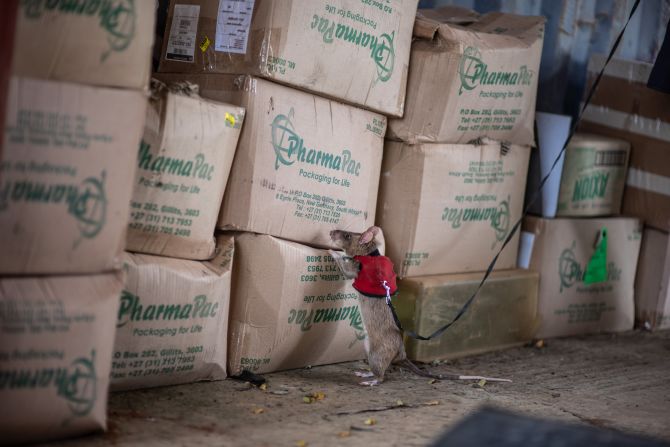While the jury is still out on whether or not the African giant pouched rat is cute, it’s harder to deny the impressive power of its nose.
Tanzania-based non-profit APOPO has already demonstrated the ability of the cat-sized rodents, which it calls “HeroRATs,” to sniff out landmines, tuberculosis, and even survivors among rubble in natural disaster zones.
But now the organization is turning its attention (and its rats’ noses) to the global illegal wildlife trade.
Estimated to be worth up to $23 billion per year, illicit wildlife trafficking is the fourth largest illegal trade industry worldwide – following counterfeit products, drugs and humans.
“Wildlife is deemed to be a low-risk commodity,” says Crawford Allan, vice president of nature crimes and policy advocacy at the WWF US, who has over 30 years’ experience working on wildlife crime. “Unfortunately, organized crime knows there’s a real weak spot in detection methods of ports, seaports and airports, particularly in Africa.”
Traffickers disguise wildlife products in a whole host of ways, he explains. Ivory, for example, might be stained to look like wood, hidden within crop shipments and even cut up into chocolate bar-shaped pieces, coated in chocolate and wrapped up in the packaging – all in an attempt slip past visual and X-ray inspections.
Sniffing out crime
This is where the rats and their acute sense of smell come in. According to new research led by APOPO and published in Frontiers in Conservation Science, the rats have been successfully trained in a research facility to sniff out elephant tusks, rhino horns, pangolin scales and African blackwood – which Allan, who’s not involved in the research, says are some of the most common wildlife products to be trafficked out of Africa.

Dr. Izzy Szott, the behavioral research scientist leading the project, suggests using rats as a “complementary tool” to dogs, which are already used to detect wildlife contraband. “Dogs are amazing. If you are looking at tracking through the Serengeti (a national park in Tanzania), you’re not going to use a rat for that,” she says. However, being “very small and agile,” rats have the upper hand in a densely packed shipping container, she explains.
Unlike dogs, the rats are happy to work with multiple handlers and, largely owing to their smaller size, are much cheaper to train, maintain, and transport, claims Szott. This is particularly important given that much of the illicit wildlife trade comes from some of the world’s poorest regions.
Allan identifies cost as the major issue in detecting trafficked wildlife products, asserting that “we need to find some cheaper, more sustainable solutions for detection in Africa.” He adds that improving detection methods increases the risk for illegal wildlife traders – which, in turn, drives up commercial prices and shrinks demand. “I’m hopeful that (using rats) for detecting wildlife will be a low cost, (high) impact, low footprint operation,” says Allan.
Kate Webb, an assistant professor in Psychiatry and Behavioral Sciences at Duke University, in North Carolina, and one of the lead authors of the study, tells CNN that one of the the biggest advantages of using rats is their relatively short training time. “There has also been interest in wildlife detection rats from Singapore and France,” she added.
Trialing these research findings in the real world, APOPO last year conducted a proof-of-concept study at the seaport of Dar es Salaam in Tanzania, which handles 95% of the country’s international trade. APOPO says the rats found over 83% of planted targets, even when items were concealed by regularly used scent-masking products. Once a rat identifies a target, it alerts its handler by using its front paws to pull a little ball attached to a custom-made, neoprene vest, which triggers a beeping sound.
The illegal wildlife trade not only impacts populations of the trafficked animal or plant, it can have devastating knock-on consequences for whole ecosystems. Studies suggest that the consumption of illegally traded wildlife can also lead to the spread of zoonotic diseases, such as the Ebola virus, monkeypox virus and severe acute respiratory syndrome (SARS).
Clever, curious learners
African giant pouched rats have an average lifespan of around eight years, so training them for one year is a worthwhile long-term investment, says Szott. The year consists of Monday through Friday training sessions, regularly interspersed with playtime in a big outdoor kennel filled with rope toys and running wheels.
The rats’ high level of intelligence and curiosity makes them good students, she explains: “If you need to get them to do something new, you just drop them in there (into a training enclosure) and wait for them to figure it out.”
Like people, each rat has a different character, she adds: “You have animals that might get it in the first try and you might have animals that take a little time, but then become the absolute superstars once they figure it out.”

Though this research is still in its early stages, APOPO is hopeful that it will scale up in a similar way to its previous projects. The team intends to carry out further operational trials with the trained rats at Dar es Salaam’s seaport and airport. The next steps will focus on optimizing deployment strategies – looking at the performance of the rats when on long leads versus free-roaming, says Szott.
She is confident the rats are up to the challenge. “So far, whatever we’ve thrown at the rats, they’ve been doing it,” she says. “If we communicate it right to the rats, they’ve always been up to the task.”
This story has been updated to clarify Crawford Allan’s statement about the impact of the rats.
Chris Lau contributed to this report.











